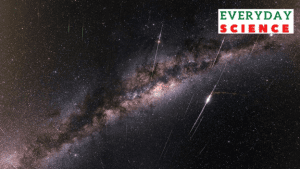TAG: GS 3: SCIENCE AND TECHNOLOGY
THE CONTEXT: The Eta Aquariid meteor shower is an annual celestial event associated with Halley’s Comet, a periodic comet that orbits the Sun approximately every 76 years.
EXPLANATION:
- This meteor shower, characterized by burning space debris moving at extraordinary speeds, is set to peak on May 5 and 6, following its activity since April 15.

Eta Aquariids meteor shower captured in the Chilean desert near an observation site.
Comets: Origin and Composition
- Comets, often referred to as frozen remnants from the early solar system, consist of dust, rock, and ice.
- They orbit the Sun in highly elliptical paths, with some orbits extending hundreds of thousands of years.
- NASA currently recognizes 3,910 comets, with countless more theorized to exist beyond Neptune in regions such as the Kuiper Belt and the distant Oort cloud.
- As comets approach the Sun, they heat up, releasing gases and dust, forming a glowing head and a tail that can span millions of miles.
Connection Between Comets and Meteor Showers
- Meteor showers originate from comets when Earth passes through the debris left behind in a comet’s orbital path.
- These debris, consisting of tiny grains of dust or rock, enter Earth’s atmosphere, burning up and creating a luminous trail.
- While most meteors disintegrate entirely, larger ones can survive the atmospheric entry, reaching the ground as meteorites.
- The Eta Aquariid meteor shower, specifically, occurs as Earth traverses the orbital plane of Halley’s Comet.
Characteristics of Eta Aquariids
- What distinguishes the Eta Aquariid meteor shower is its rapid speed, resulting in long, glowing tails that can linger for several minutes.
- Observers in the Southern Hemisphere typically have a better view, with about 30 to 40 meteors visible per hour during peak activity.
- In contrast, those in the Northern Hemisphere may witness fewer meteors, around 10 per hour, often in the form of ‘Earthgrazers,’ elongated meteors skimming the Earth’s surface.
- This discrepancy in visibility is attributed to the shower’s radiant, the apparent point in the sky from which the meteors originate, which is positioned favorably for Southern Hemisphere observers.
Spotting the Eta Aquariid Meteor Shower
- The Eta Aquariid meteor shower is best observed under conditions of minimal light pollution, preferably on a clear night sky.
- The radiant of the shower is located within the Aquarius constellation, hence the name ‘Eta Aquariid.’
- To enhance visibility, observers can use basic telescopes, although the shower is visible to the naked eye.
- Avoiding interference from the Moon or artificial lighting sources, such as streetlights, will optimize the viewing experience.

